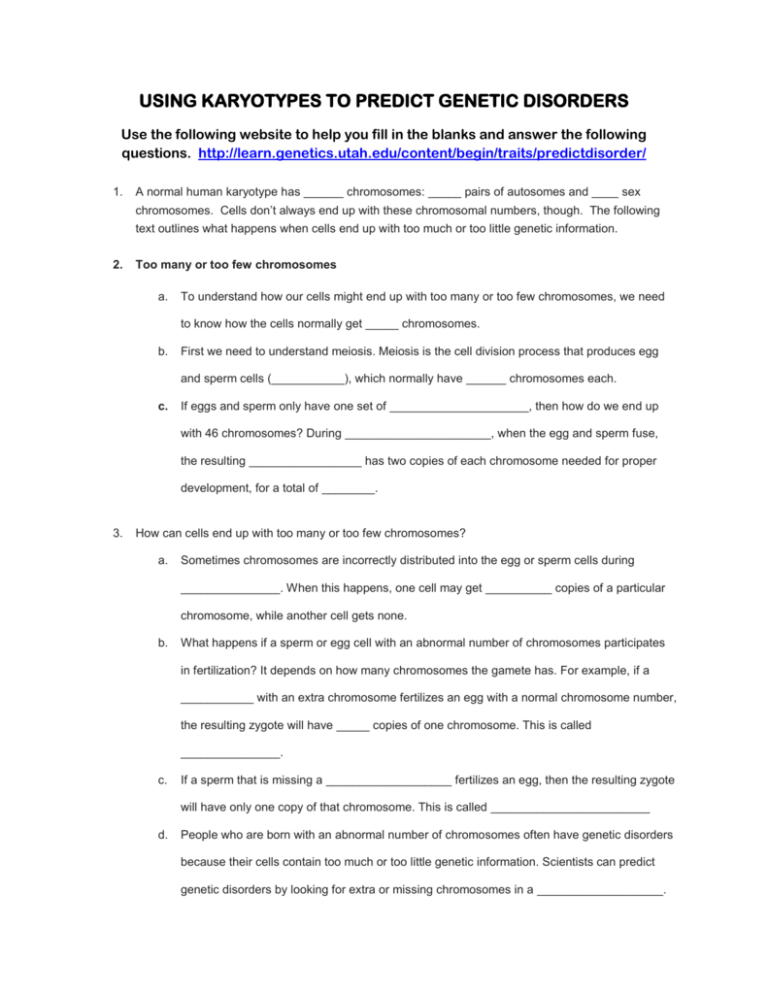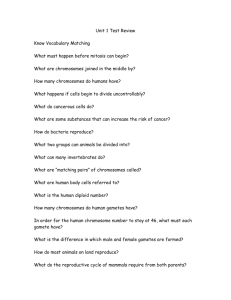USING KARYOTYPES TO PREDICT GENETIC DISORDERS
advertisement

USING KARYOTYPES TO PREDICT GENETIC DISORDERS Use the following website to help you fill in the blanks and answer the following questions. http://learn.genetics.utah.edu/content/begin/traits/predictdisorder/ 1. A normal human karyotype has ______ chromosomes: _____ pairs of autosomes and ____ sex chromosomes. Cells don’t always end up with these chromosomal numbers, though. The following text outlines what happens when cells end up with too much or too little genetic information. 2. Too many or too few chromosomes a. To understand how our cells might end up with too many or too few chromosomes, we need to know how the cells normally get _____ chromosomes. b. First we need to understand meiosis. Meiosis is the cell division process that produces egg and sperm cells (___________), which normally have ______ chromosomes each. c. If eggs and sperm only have one set of _____________________, then how do we end up with 46 chromosomes? During ______________________, when the egg and sperm fuse, the resulting _________________ has two copies of each chromosome needed for proper development, for a total of ________. 3. How can cells end up with too many or too few chromosomes? a. Sometimes chromosomes are incorrectly distributed into the egg or sperm cells during _______________. When this happens, one cell may get __________ copies of a particular chromosome, while another cell gets none. b. What happens if a sperm or egg cell with an abnormal number of chromosomes participates in fertilization? It depends on how many chromosomes the gamete has. For example, if a ___________ with an extra chromosome fertilizes an egg with a normal chromosome number, the resulting zygote will have _____ copies of one chromosome. This is called _______________. c. If a sperm that is missing a ___________________ fertilizes an egg, then the resulting zygote will have only one copy of that chromosome. This is called ________________________ d. People who are born with an abnormal number of chromosomes often have genetic disorders because their cells contain too much or too little genetic information. Scientists can predict genetic disorders by looking for extra or missing chromosomes in a ___________________. 4. Missing pieces of chromosomes a. In some cases, genetic material is missing from a chromosome. Such chromosomes are said to have __________________. b. Deletions large enough to be seen in a karyotype result in the loss of many _____________. In humans, these are less comman than deletions that remove small portions of a chromosome. c. A _________________________ is a chromosome rearrangement in which part of a chromosome breaks off and then reattaches to a different chromosome. QUIZ: Use the options listed below and your knowledge to answer the following questions. Some options will be used more than once. Normal female Turner Syndrome Normal male Klinefelter Syndrome Down Syndrome 1. _______________________ 5. _______________________ 2. _______________________ 6. _______________________ 3. _______________________ 7. _______________________ 4. _______________________ 8. _______________________








